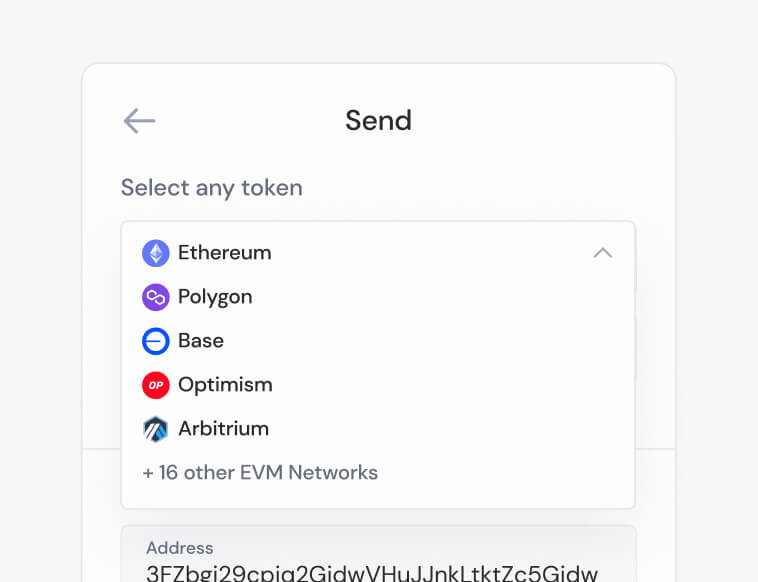Build on Top of Ethereum’s Ever-Growing Ecosystem
Learn how Dynamic equips developers with the tools that they need to build on Ethereum and EVM-compatible blockchains.

Build around millions of users
Onboard users in seconds to EVM networks
Easily deploy apps across EVM chains
What are EVM networks?
EVM-compatible networks are chains that can run the Ethereum Virtual Machine (EVM) and execute smart contracts on Ethereum.
Ethereum has established itself as the home of DeFi, hosting an extensive list of dApps and a large number of developers and active users. However, while Ethereum excels in decentralization and security, it has faced issues scaling efficiently. To combat this, EVM-compatible networks harness Ethereum’s security while offering faster and cheaper transactions, along with other specialized use cases.
Dynamic projects building with the EVM





Ethereum is constantly expanding
$100B+
Of TVL across EVM chains
3M+
Daily users of EVM networks
110+
EVM chains have $1M+ of TVL
What’s being built within the Ethereum ecosystem?
Applications that want to leverage the security and large user base of Ethereum while integrating with surrounding EVM networks.
Layer-2 Blockchains
Layer-2s provide Ethereum with an efficient way to scale and meet the needs of new innovations, while bringing users cheaper and faster transactions.

DeFi Protocols
Due to its high level of security, decentralization and interoperability between EVM-networks, Ethereum is home to a booming DeFi landscape.

Community Experiences
Ethereum was the original hub for NFT communities and continues to host a strong presence of innovative brands and Web3 experiences.
.svg)
Start building on EVM chains
Wallets that matter for EVM networks
The top wallets used across EVM networks
Dynamic supports a growing list of wallets within this ecosystem, with mobile deep linking, multi-wallet handling, merging and transaction/signing handling.





Blending Innovation with Bear-Themed Culture
Berachain has generated a lot of attention, due to its unique approaches to enhancing performance, scalability, and functionality for decentralized finance (DeFi) applications. Berachain has introduced a tri-token model and novel consensus mechanism, making it one of the most innovative emerging blockchains.

Pioneering retail to web3 shopping
Pudgy Penguins is a distinguished Web3 brand known for its unique content, merchandise, toys, and digital collectibles, aiming to create a user-friendly, Web3-powered retail experience.

Revolutionizing Immersive Storytelling with Doodles
Doodles is a next-generation entertainment company focused on immersive storytelling through the creation and distribution of live and digital experiences, original content and lifestyle products.
.jpg)
Blending Innovation with Bear-Themed Culture
Berachain has generated a lot of attention, due to its unique approaches to enhancing performance, scalability, and functionality for decentralized finance (DeFi) applications. Berachain has introduced a tri-token model and novel consensus mechanism, making it one of the most innovative emerging blockchains.

The Evolution of SVM Chains (Solana Virtual Machine)
Your guide to the Solana Virtual Machine: what it is, why it matters, and innovative projects that are leveraging it.

Blending Innovation with Bear-Themed Culture
Dive into the Berachain ecosystem and how it is forming one of the most active and vibrant communities in crypto.

Key terms to know
Crypto Bridges
Bridges allows end-users to transfer tokens such as ETH across different blockchain networks.
Staking
For networks utilizing proof-of-stake consensus, staking allows token holders to secure the underlying network and verify transactions while earning rewards in return.
Gas Fees
A measurement (in Gwei) of how busy Ethereum’s network is at any given time, which dictates the cost of transactions on EVM networks.
Nakamoto Coefficient
Named after the anonymous founder of Bitcoin, this metric is a quantitative measure of how decentralized any given network is.
EIP
Ethereum Improvement Proposals (EIPs) are standards submitted by Ethereum community members that specify potential new features or processes for Ethereum.
ERC
Ethereum Request for Comments (ERCs) define the rules and specifications required for creating new tokens and smart contracts.
FAQs
When did Ethereum launch?
After its whitepaper initially debuted in 2013, Ethereum created its genesis block and went live as a network in 2015. The Ether (ETH) token also went live at this time, but was sold the year prior in the form of a presale raising $18M.
How many EVM networks are there?
There are countless EVM networks in crypto, with new ones going live each month. More specifically, there are currently ~95 EVM networks that have $1M or more of TVL. The most popular EVM networks are Binance Smart Chain, Polygon, Avalanche and Base.
What are the benefits of EVM-compatible networks for developers?
EVM networks appeal to developers due to their use of familiar coding tools and languages, and their compatibility across different networks. Developers can easily deploy existing projects on other EVM networks, opening up their apps to new user bases and opportunities.
What differentiates EVM networks from one another?
Even though they share the same underlying tech and settlement layer, EVM networks differ from one another in a list of ways. These networks may have different consensus mechanisms, governance models, gas tokens, transaction costs, and communities.
Set up your BitcoinKit now!
The first and best Bitcoin wallet adapter.

Additional resources covering EVM
A simple explanation of how Account Abstraction is creating a more seamless and accessible Web3 world.
Read more

Discover why Base has become a leading choice among users and developers as one of the most popular layer-2 solutions.
Read more





















